Artnet News Pro
How Much Does It Cost to Acquire a Viral Yayoi Kusama Infinity Room? Is Money Even Enough? The Answers May Surprise You
The works' complexity requires a major commitment from owners.
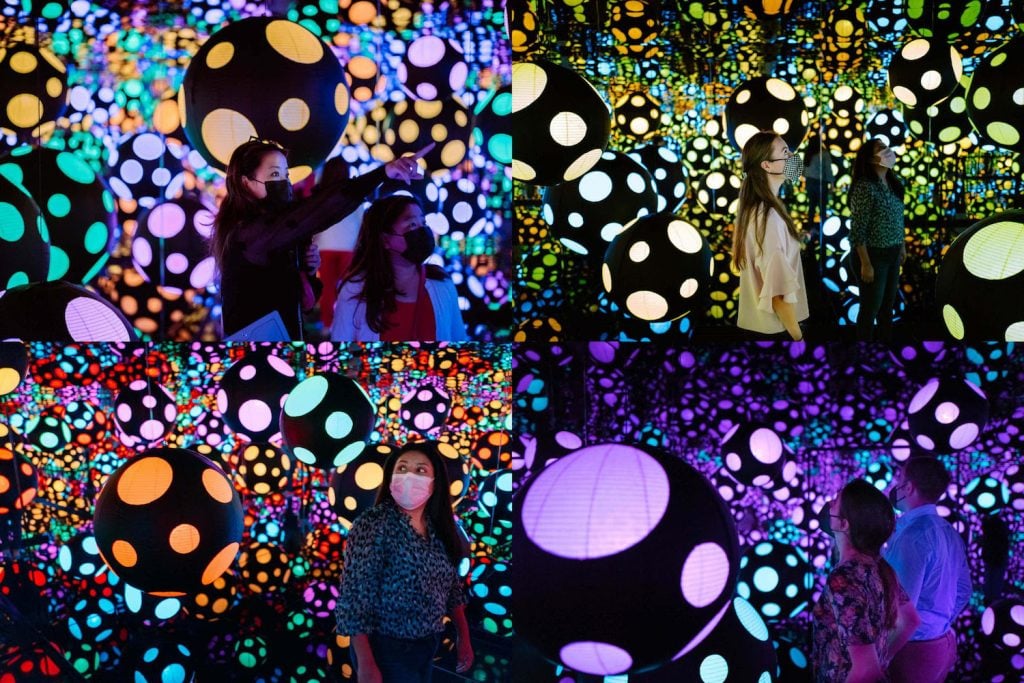
The works' complexity requires a major commitment from owners.

Eileen Kinsella

Whether it’s New York, Los Angeles, or Berlin, when one of Yayoi Kusama’s Infinity Rooms goes on view, a line springs up seemingly instantaneously and snakes around city blocks, where eager viewers stand waiting, sometimes for hours on end. It’s all for the chance to step inside one of the Japanese artist’s glowing, light-filled, immersive installations and snap as many selfies or portraits as possible in the typical 60-second time allotments, which (as anyone who has visited knows) are strictly enforced by the security guards who attend each Infinity Room entry door.
In 2017, a touring show that debuted at the Hirshhorn Museum in Washington, D.C. displayed an unprecedented six rooms at once and traveled on to four other North American locations. It was “the first to place the artist’s Infinity Mirror Rooms at the center of her practice,” according to the museum’s director, Melissa Chiu,
The Hirshhorn welcomed a record 475,000 visitors—the highest spring visitation since its opening in 1974—and doubled its attendance that year, to 1.2 million visitors. The show’s #InfiniteKusama hashtag extended to more than 172 million Twitter and Instagram accounts and generated more than 716 million impressions, according to the Hirshhorn.
With stats like those, what museum wouldn’t want to acquire and construct one of these viral global sensations as a secret weapon for attendance? So how do you get one? The answers might surprise you.
For starters, the rooms’ prices are shockingly low in the realm of contemporary art, especially compared with similarly in-demand stars like Jeff Koons or Andy Warhol, who can command eight figures, or even some ascendant emerging artists. As recently as six years ago, prices for some smaller rooms were well under $1 million, although since then they have understandably been ticking up and now range from six figures into the many millions, sources say.
Despite their fame, the Infinity Rooms do not rank among Kusama’s most expensive works. Her record at auction, $8 million, is for a painting of one of her signature polka-dotted black and yellow pumpkins, according to the Artnet Price Database. It’s followed by $7.9 million for one of her white Infinity Net paintings. In fact there is not a single Infinity Room in the 100 highest auction prices, out of more than 8,000 auction entries in the Price Database.
Kusama made her first Infinity Room (Phalli’s Field) in 1965, with thousands of soft, polka-dotted phallic objects places against reflective surfaces. (It now resides in the Hirshhorn’s permanent collection.) Over the years, the concepts have become more elaborate, with illuminated objects ranging from bulbs to lanterns to pumpkins creating the illusion of “infinity” to dazzling effect. There are at least 20 distinct versions. One source said the rooms typically run in editions of three, but others said there is no set amount and it’s up to the artist’s discretion.
David Zwirner, which co-represents the artist, declined to participate in this story, and neither London-based Victoria Miro nor Tokyo-based Ota Fine Arts responded to interview requests. In response to an email to the artist’s studio, Artnet News was informed that the artist does not speak to the creation process as she simply wants viewers and the public to enjoy the works.
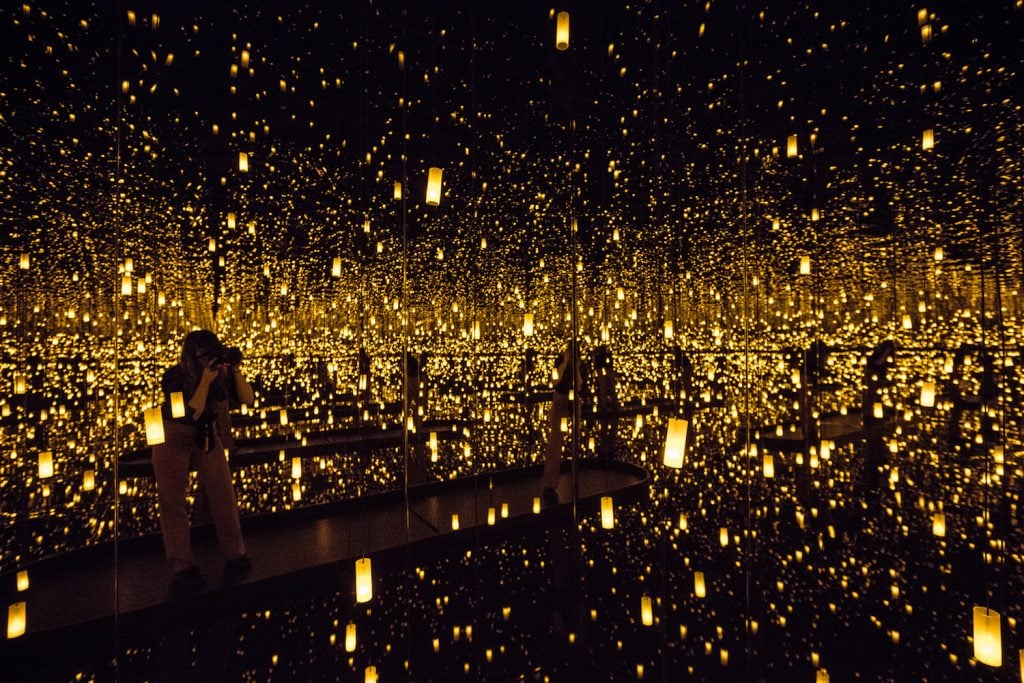
Installation view of “Yayoi Kusama: Infinity Mirrors” at the Seattle Art Museum. © Seattle Art Museum. Photo: Natali Wiseman.
More than price, the works’ size and complexity may be a barrier for many buyers. Sources said each Infinity Room comes with its own tailored manual for installation and maintenance.
Art advisor Todd Levin has more experience than most, having acquired two Infinity Rooms for a client at Art Basel Miami Beach in 2016. They were priced at $450,000 each, but he says they would definitely cost more now, likely in the realm of $1 million apiece.
“These are highly technical artworks in terms of their fabrication, and require experience and expertise to install properly,” said Levin. “I had to witness the entire process a couple of times in order to fully understand the finer detailed points of construction….Objects this intricate in terms of their physical construction and the aesthetic concerns of the artist are never as simple to install as one first imagines.”
“At this point I’ve got the installation process down to a science. I know exactly what is required in terms of manpower, the time frame, and the cost,” he added.
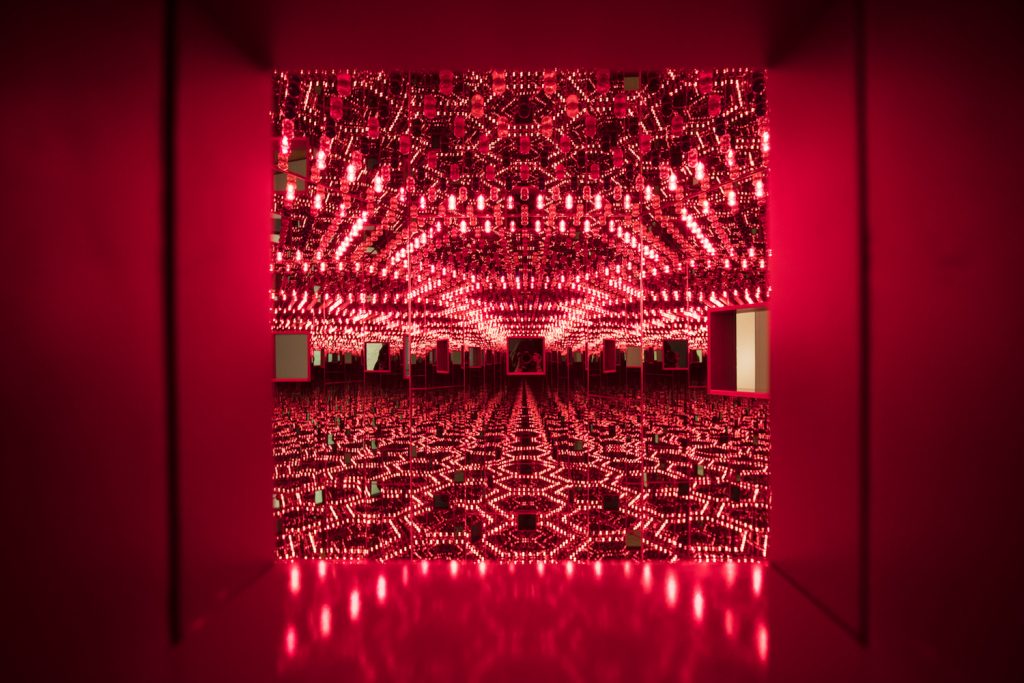
Installation view of “Yayoi Kusama: Infinity Mirrors” at the Seattle Art Museum. © Seattle Art Museum. Photo: Natali Wiseman.
He relies on a Kusama studio-approved, London-based firm known as the Whitewall Company, which knows virtually every bolt, bulb, and mirrored component of the rooms. Whitewall did not respond to Artnet News’s interview requests.
“They’re the only team I’ll allow to install the artwork. Whitewall has to be on site to un-crate the artwork and do the initial inspection report to confirm everything arrived on site as it was when it left the client’s storage. They are then responsible for assembling the artwork and dealing with any exigencies, such as the doorframe being out of alignment or a panel not properly fitting into its location,” Levin explained. When it’s time to deinstall, Whitewall comes out a second time and “everything is played in reverse. That is the only way we will loan the artwork to institutions.”
One of the most complex aspects is getting the lighting just right, said Seattle Art Museum modern and contemporary art curator Catharina Manchanda. The museum hosted the major touring show in summer 2017, after the Hirshhorn. “You want to have a soft glow,” she said, and avoid any glaring spots. The rooms are built to the artist’s specifications and then mirrors, lighting, and sculptures follow.
On the whole, Manchanda said the show was traveling fairy easily, and “it was all very clearly laid out how to do everything.” But technical glitches occurred from time to time—as with one Infinity installation that ran on Japanese voltage. “I remember we had a hard time. We needed a specialized electrician to get it going….So those are the kinds of tricky things you have to fiddle around with,” said Manchanda.
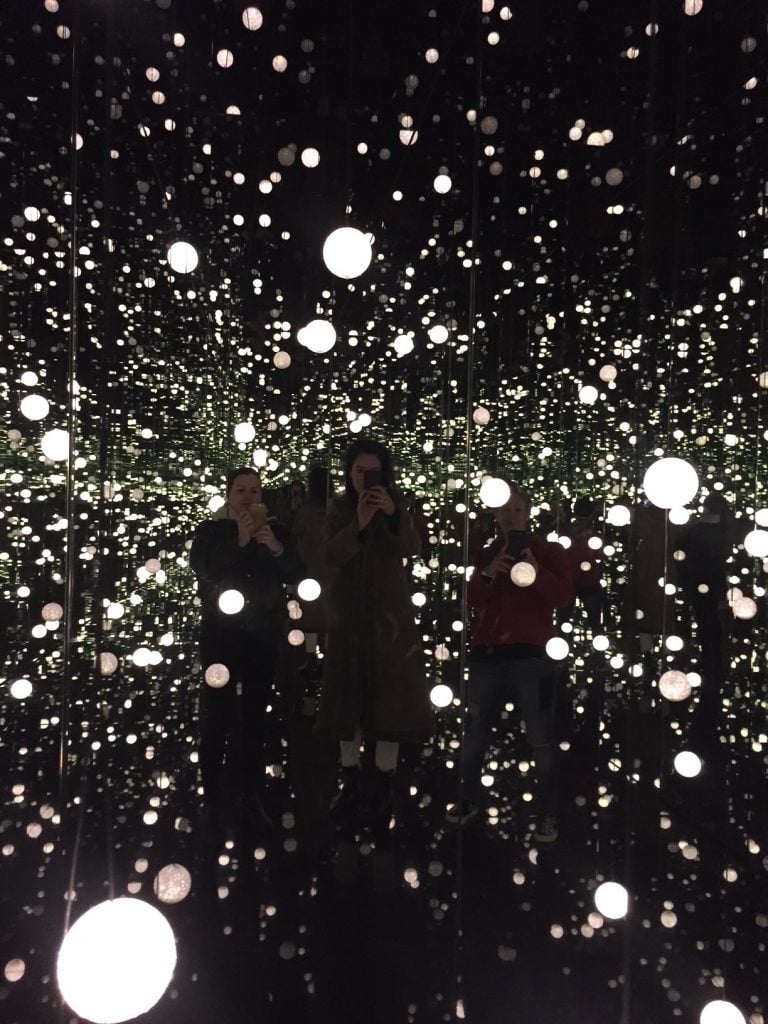
A Yayoi Kusama Infinity Room at David Zwirner gallery in New York. Photo by Eileen Kinsella.
“We bought an Infinity Room for Inhotim quite a number of years ago,” said art advisor Allan Schwartzman of the contemporary art center in Brazil founded by collector Bernardo Paz. They acquired it from Gagosian, but it remained on loan to a museum and was never installed. Designers at Inhotim are now finalizing plans for a pavilion to permanently house the work, and Schwartzman expects construction to begin before the end of the year.
Schwartzman notes that the work, titled Mirrored Room—Aftermath of Obliteration of Eternity (2009), features a water element, which is “responsible for much of the reflection and a sense of calm and groundedness. Reflections in water give a fundamentally different quality than reflections in mirrors,” he notes.
“Like many works of art that are made of technology and experiential in nature, issues of preservation and continued healthy visitation will always be a part of the life of these works,” says Schwartzman. “And we all take this on knowingly.”
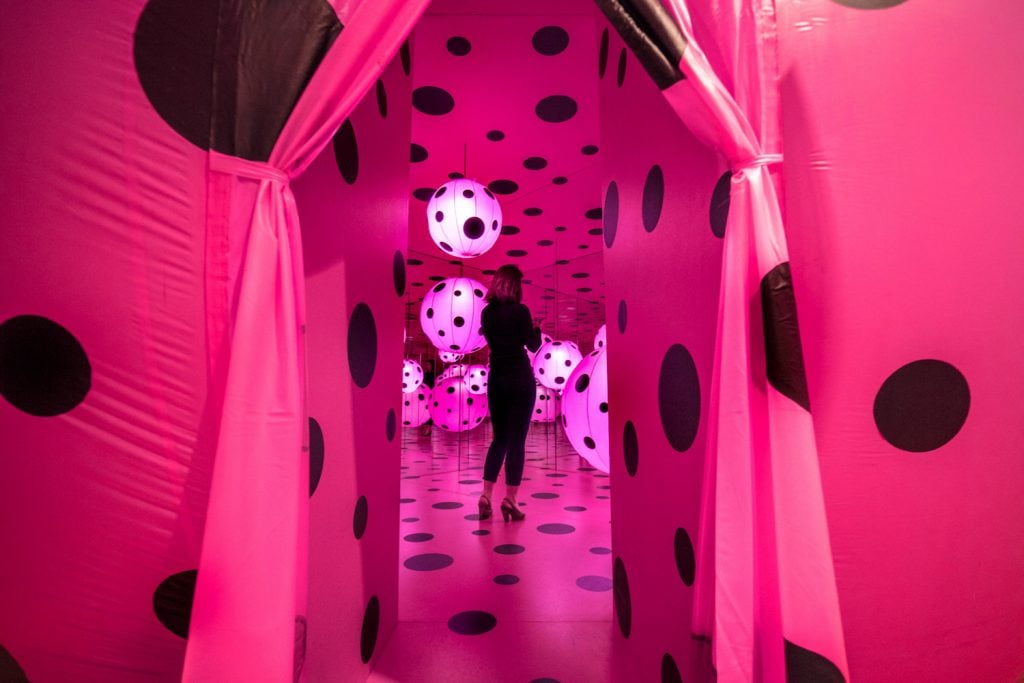
Installation view of “Yayoi Kusama: Infinity Mirrors” at the Seattle Art Museum. © Seattle Art Museum. Photo: Natali Wiseman.
However, the water element has proved too challenging for some. “Most museums have a hard time with actual water, which can leak and attract mosquitoes and flies,” said Manchanda. That may be part of why the artist made tweaks to at least one Infinity Room, Fireflies on the Water, by replacing the actual water with mirrored surfaces on the floor.
For years, the Albright-Knox Art Gallery in Buffalo, New York, had wanted to acquire an Infinity Room as part of its planned expansion, which is currently under way. This meant years of conversations with the artist’s galleries, as well as internal conversations with the museum’s acquisitions committees, chief curator Cathleen Chaffee recounted in a phone interview with Artnet News.
“We were focused on trying to add an immersive work to our collection as we are thinking about having more space. This was something we really wanted to share with our audience in Buffalo and those who visit us here,” said Chaffee.
In a case of art-world serendipity, Chaffee was on a trip to London a few years ago during the Frieze art fair when she visited Victoria Miro gallery, where Infinity Mirrored Room—My Heart Is Dancing into the Universe (2018) was on view. Also there that day was Hirshhorn director Melissa Chiu, with a group of patrons in tow.
Since the work was available, “it’s conceivable that we might have each acquired an edition,” Chaffee said. “But we very quickly realized that we both shared an interest in this work,” and collaborative conversations ensued (the Albright-Knox has jointly acquired major works with other institutions over the years, including a Félix Gonzéles-Torres with the Tate, a Nick Cave installation with the MCA Chicago, and a multistory Rachel Whiteread with the Carnegie Museum).
The Hirshhorn is debuting the work, along with another Infinity Room it recently acquired, in an exhibition opening April 1. The Albright-Knox will make the room a centerpiece of its display when it reopens after renovation. Echoing Levin’s belief that practice makes perfect and communication is key, one of the Albright-Knox’s lead art handlers traveled to the Hirshhorn for the sole purpose of observing the recent installation.
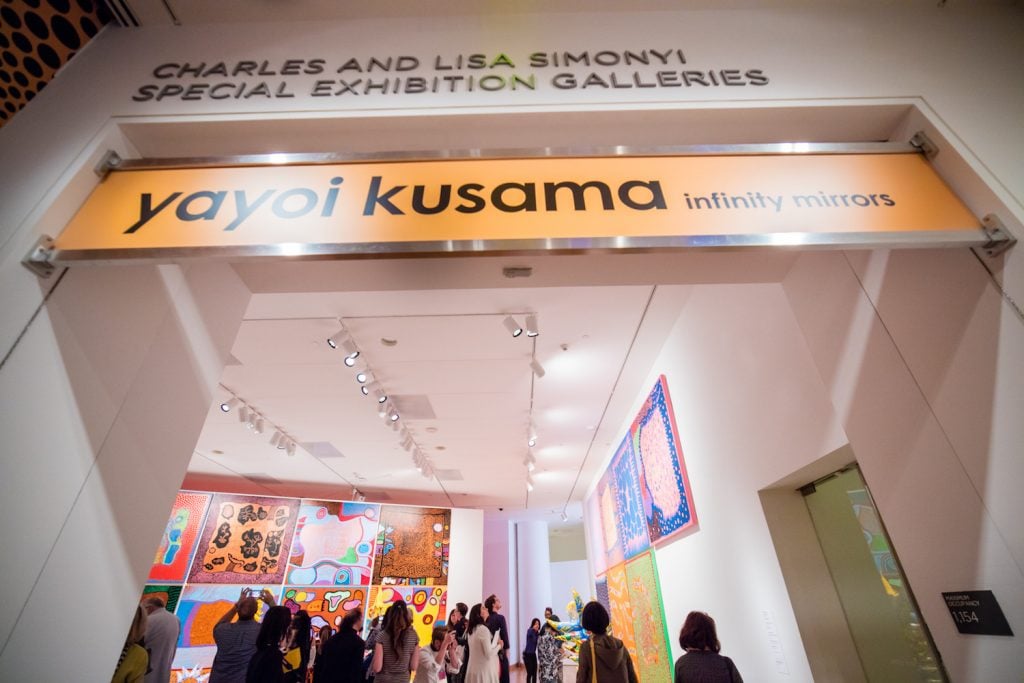
Installation view of “Yayoi Kusama: Infinity Mirrors” at the Seattle Art Museum. © Seattle Art Museum. Photo: Natali Wiseman.
Like some great works of art, the Infinity Rooms were not immediately and universally appreciated. Manchanda recalled visiting one at the Whitney Museum (which also owns one) as part of a biennial more than two decades ago, while she was a student in New York.
“The biennials were always crowded, but I was the only person in line wanting to see it. There was no interest whatsoever. I can’t even remember if there was a specified time limit. Also, it was in the 1990s, so not everyone carried around a camera.” Smartphones and social media have undoubtedly contributed to the rooms’ viral popularity today.
Schwartzman, for one, hopes that a balance can eventually be struck. “These works are so magical and transporting in multiple ways, that to be alone in one is a singular experience. Unfortunately, many of them are exhibited in temporary situations, and because of the great demand, the experience ends up being a little bit like an assembly line…in and out in in 30 or 60 seconds, or whatever the timing may be.”
He continued: “My great hope with these works, particularly with those that can’t be installed permanently, is that the institution—or whoever exhibits it—will be able to restore the privacy of the experience as it was originally intended.”